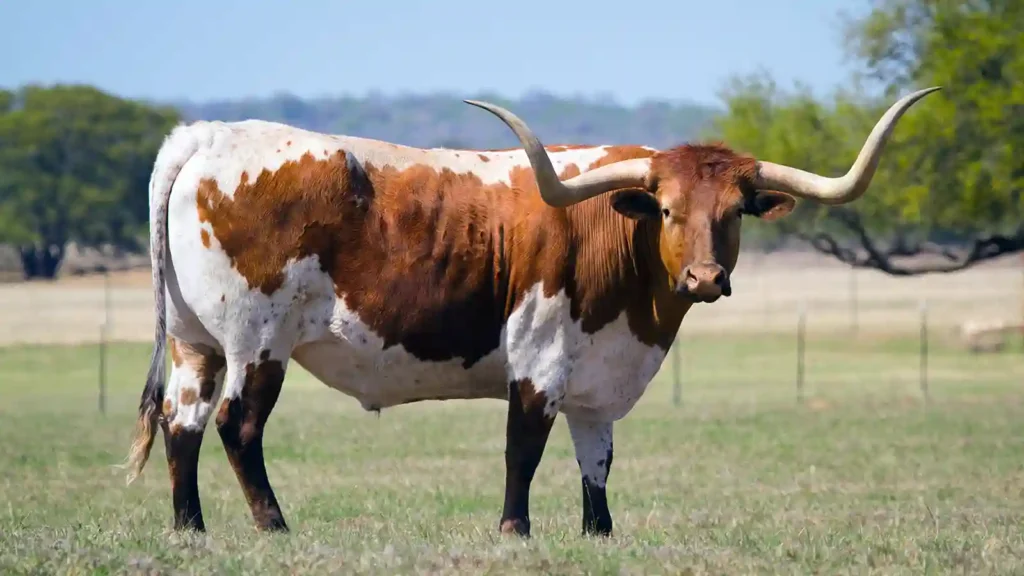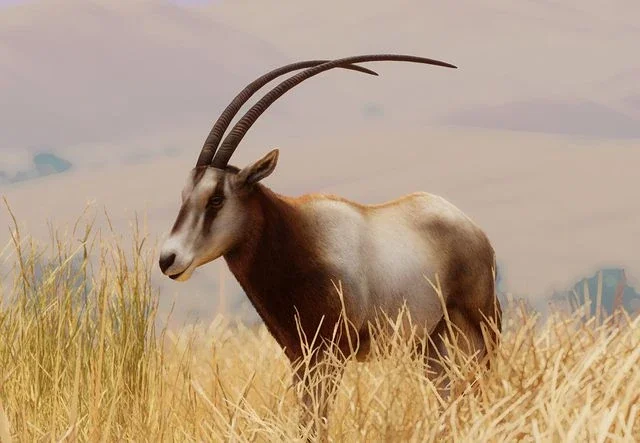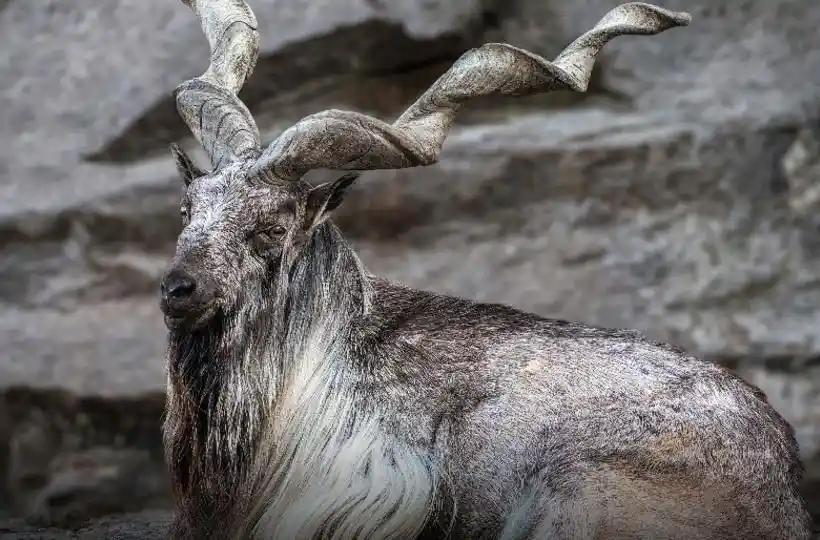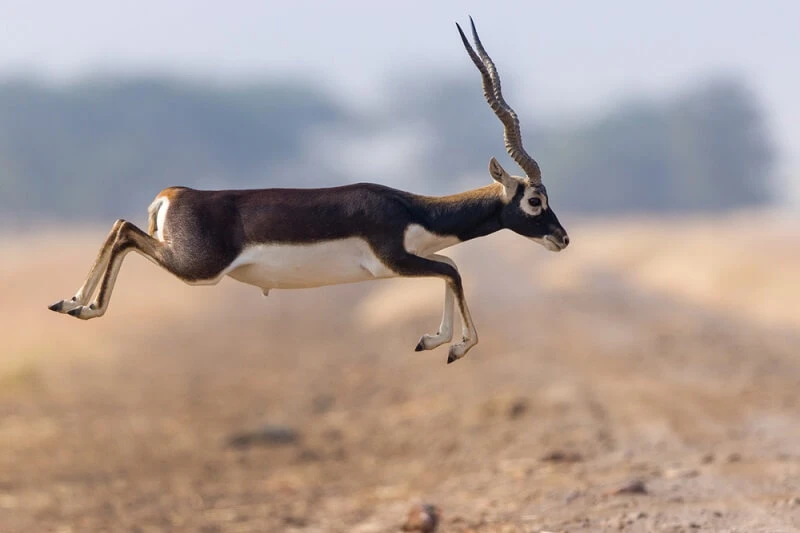If you’re looking for the Animals With The Biggest Horns, then you are at the right place. In this article, we will discuss the Top 10 Animals With The Biggest Horns in The World.
All creatures have one or more striking features that modify their appearance. Some have beautiful feathers, like the peacock; others have unusual teeth, like the beaver, which has orange teeth. In today’s content, we focus on the Animals With The Biggest Horns. For most people, the size of an animal’s horns should grow according to their body size, but in some special cases, this is not the case, as some animals have the biggest horns that you may have never seen. Welcome to this roundup. If you’re wondering if there’s a real-life version of the giant bull from “Kong – Skull Island,” you should stay until the end, it will surprise you.
Let the countdown begin! Take a look at the 16 animals with the biggest horns in the world.
Animals With The Biggest Horns
1. Texas Longhorns

This kind of cattle has the longest horns in the world. Individuals in the population can generally exceed 2 meters. Among them, the world record holder for the longest horns is a Texas Longhorn JR from Queensland, Australia. The length of the horns can reach 2.7m, you can accidentally injure a large audience by twisting your head. Although the Texas longhorn cattle with the longest horns are in Australia, judging from the name, people probably think that this kind of longhorn cattle is native to the United States.
In fact, this guy’s ancestors The Spanish longhorn cattle came to the Americas with the colonists around the 16th century. They were mostly bred in Mexico at first, but later gradually spread to the United States. They were widely praised at the time. After nearly 450 years of cultivation, until 1964, The Texas Longhorn is officially a breed,
In fact, their horns can grow to 50% of the total length when they are one year old. , it reaches 95% at the age of 5 or 6, so the length of the horns at the age of 7 or 8 is probably the same in this life. As the age increases, the horns grow slower and slower, and there are traces of this growth, which can be passed through These “growth rings” determine its age.
2. Ankole Watusi

See those big horns? How do they look? Pretty scary, right? Except for the Ancora long-horned bull, no animal dares to project its horns like this. Ankola longhorn cattle, also known as Watusi longhorn cattle, are a modern American hybrid breed derived from the Central African Sanga cattle (another big horned cattle) breed. They may come in many different colors such as black, white, brown, mixed colors, etc., however, red is the most common.
The horns of this kind of cattle are very large and widely distributed. Normally, their horn length is about 70 centimeters. In 2004, an Ancora longhorn named CT Woodie was named in the Guinness Book of World Records because of its big horns. The horn circumference reached 1.1 meters. The world record for the biggest horns does not belong to CT Woodie but from another Ancora longhorn named Lurch, whose horn length reaches 95.25 centimeters.
3. Sanga Cattle

The owner of this pair of big horns is the Sanga cow. It comes from Uganda, Africa. Its horns can reach 2 meters long. When standing properly, it can pierce the ceiling. This pair of long horns looks like the horns of a devil. It is very powerful. It feels like an ancient totem, but these horns are not only used for decoration.
They are also an important tool used by Sanga cattle to compete for mates. Physiologically speaking, this is beneficial to blood circulation and dissipates heat very quickly in high-temperature environments. , although this guy is a unique breed of cattle in Africa, its ancestors are actually European aurochs. In history, they flowed into Africa through Ethiopia.
However, this kind of beautiful cattle is slowly disappearing. On the one hand, this kind of cattle is too old, and its role and benefits are far inferior to those of exotic cattle. It is natural for herdsmen to give up in order to survive. On the other hand, it is The crossbreeding of various exotic cattle has resulted in a very low proportion of purebred Sanger cattle. Now only the Bahma people are still engaged in Sanger cattle breeding.
I don’t know if you are familiar with this pair of big horns. It is easily reminiscent of a cartoon. Yes, it is the biggest horns bull in “Mavericks”. Although its prototype is a local cattle, this horn Definitely a reference.
4. Narwhals

The unicorns of the sea, pale-colored dolphins called narwhals, are found in Arctic coastal waters and river midlines. They are from the same family of marine mammals as dolphins and killer whales, but their horns make them stand out. This unique horn or oversized tooth can grow up to 3 meters long.
This sword-like spiral tusk sprouts from the narwhal’s lip. Scientists are not sure what the tusk is used for. Some think it is used to attract the mother, like a high hat or a trendy hairstyle. It may even be used to attract the mother. Used in fights with male opponents, it may seem a little painful.
5. Wild Water Buffalo

The Asian water buffalo with the biggest horns is the one found in India, Nepal, and Thailand. The water buffalo carries a huge crescent-shaped horn that grows backward. Its average length is close to 1.5 meters, and sometimes it is so long that it almost touches each other.
Researchers in 1955 discovered a bull that was more like a story, with its horns almost 4.27 meters apart. Wild buffaloes are awe-inspiring mammals that use their horns to protect themselves, even against lions and tigers. But if frightened, the buffalo can reach speeds of 48 kilometers per hour.
6. Alpine ibex

Ibex is also called ibex or Alpine ibex. They are a sexually dimorphic species that live among the rocks on the snowy tops of the European Alps. Unlike other sheep families, ibex have short and wide heads. Their hair is brown-gray in summer and turns dark brown in winter.
Male ibex can generally grow to 1 meter tall and weigh 100 kilograms, while female ibex are mostly half the size of males. In addition to body size, the biggest difference between males and females is the conspicuous beard. Both male and female ibex have large and backward-curving horns. They have one of the biggest horns in the world. The male’s horns can grow up to 1 meter in length, with a maximum length of 1.47 meters. They use their horns to protect themselves from predators such as wolves, lynxes, bears, jackals, and foxes.
This type of sheep is naturally social. Although adult males and females are isolated for most of the year, male ibexes usually gather in groups in summer. Only during the estrus period in late autumn, does male ibex Only then will they leave the herd and search for the female ibex group alone.
7. Moose

The moose is the largest existing deer in the world, with a shoulder height of 2.4m and a weight of 1 ton. It feels like a baby elephant walking on the street. Naturally, it also has the longest antlers. The length of a single antler can reach 1.8m. It is already much taller than most people. Not only is it large in size, it is widely distributed. It is basically distributed in high latitudes throughout the northern hemisphere. Thanks to its huge size, it can survive in 60cm thick snow.
It can run at speeds up to 55km/h, which is 30cm for ordinary people. It can no longer walk. Even as a land beast with a weight of up to 1 ton, it is still a good swimmer and can swim for more than 20 kilometers continuously. If it encounters danger, You can completely evade it by jumping into the river. It can be said to be a proper pentagonal warrior. Because of this, moose are invincible when they reach adulthood.
However, due to the large-scale hunting of wild wolves by Canadians, moose have lost their balance and their numbers have increased. Without the threat of natural enemies, this thing is just a food machine, causing great damage to the ecology. They also like to hang out in human cities, and Canadians have to clean up some every year.
8. Scimitar Oryx

The scimitar-horned oryx, also known as the Saharan oryx, is a species of antelope. They were once a mammal that lived widely in North Africa, but they became extinct in the wild in 2000. It was not until 2016 that zoologists reintroduced the bred scimitar-horned oryx into the wild. Of course, you can still see them in zoos.
Both sexes of the scimitar-horned oryx have horns. The horns are very long and curve back like a scimitar. At the same time, the horns are shaped like screws with many spiral threads. Both sexes have horns, but women are slimmer. The horns are long, thin, and symmetrical. They curve backward and can reach 1.0-1.2 meters in both males and females. The horns are very thin and break easily.
9. Saiga Antelope

The saiga is a species of antelope that can be found in Central Asia and Alaska. Saiga antelopes grow from 2 feet to 2 feet 7 inches and weigh between 36 and 63 kilograms. In this species, only males have horns. They wrap around the bottom and sit vertically. Horned males are larger than hornless females. Their lifespan varies from 6 to 10 years.
The horns are used in fighting during the mating season and the fighting is very aggressive. After the collapse of the Soviet Union, their population declined dramatically due to medicinal hunting and uncontrolled demand for horns.
10. Markhor

The markhor is a large wild goat. It is also known as Shakhawat. Kudu is thought to be a Persian name for the snake, either because of the kudu’s big horns or due to its ability to kill snakes.
Both male and female Tortora corals are tightly curled, like spiral horns, with their heads close together but spreading upward toward the tips. The male’s horns can grow up to 160 centimeters long, and the female’s horns are up to 25 centimeters long. Hunting kudu is illegal in India, but they hunt them illegally for food and horns.
11. Reindeer

Reindeer are called caribou or wild reindeer, especially in Alaska. Reindeer and caribou are the same species. They are the only deer in which both males and females have antlers.
The antlers grow forward and reindeer use them in winter to dig into the snow for food. The antlers of large stags can be up to 100 cm wide and the beam length can be up to 135 cm. They have the largest antlers relative to body size among living deer species.
12. Giant Eland

The giant Eland is also known as the Derby Eland. Giant Eland is herbivore, eating grass, leaves, and twigs. Both males and females have tightly wrapped V-shaped horns. The male is 123 cm long and the female is 66 cm long. The male’s horns are thicker at both ends, longer, and more spread out than those of the female. Giant elands dig mineral licks with the help of horns to loosen the soil.
13. Bharal

The spirit of the Himalayas is finally here! The Bharal is a beautiful animal with blue-grey fur. Like most sheep, male blue sheep also have one of the most beautiful and big horns, which are very wide and smooth. The length is generally about 60 cm, with the highest record being 84.4 cm. But the female’s horn is very short, only about 13 centimeters, with a flat base, and straight horn, gradually becoming tapered upwards, and the cross-section is almost round. Although they are mostly blue-gray with a white belly, males have black stripes on the front edges of their limbs, while females do not.
14. Indian Blackbuck

Blackbucks prefer to live in mountains where vegetation grows as this is their main food. Blackbucks are adept at climbing rocks, a skill that gives them a huge advantage over predators such as snow leopards and wolves. They are often found running along rocks or cliffs, much like the Scimitar-horned Oryx.
Blackboards are native to the Indian subcontinent. The blackbuck is the only living species of the genus Oryx. Only males have horns. The Indian blackbuck is not very large, but it does not prevent them from growing very spectacularly.
The male of this animal has a V-shaped long spiral horn, which is 45.6–68.5 cm long and up to 71 cm long. Angular cylinders are divergent, spiral, and ring-shaped, generally twisted 3-5 times. Female sheep usually have no horns.
These horns are divergent, cylindrical, spiral, and ring-shaped. The rings move closer to the skull. They are very fast. The speed exceeds 80 km/h. Wolves are the primary predators of young deer and adults.
15. Addax

Addax is also known as the white antelope and screwhorn antelope. These live in the Sahara Desert. Addax has a long, twisted horn, usually 55 to 80 centimeters in females and 70 to 85 centimeters in males. The horns, which can be found in both males and females, have two to three twists. The lower and middle parts of the horn are marked with a series of 30 to 35 ring-shaped ridges.
16. Mouflon

The mouflon is a subpopulation of wild sheep. Mouflon has a lovely reddish-brown color with light-colored saddle patches. All males have horns, and some females also have horns. A mature ram’s horns are bent in almost a full circle and are up to 85 cm long. Mouflon live in the Caucasus, northern and eastern Iraq, and northwestern Iran.
Conclusion
These were the 16 animals with the biggest horns in the world. If you know about more animals with the biggest horns then please comment below in the comment box.




